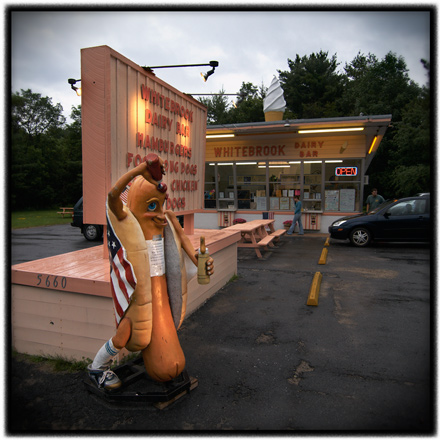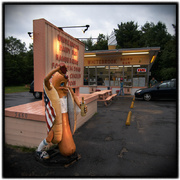civilized ku # 89 ~ a photograph is not a painting (in so many ways)
 Thursday, July 24, 2008 at 09:35AM
Thursday, July 24, 2008 at 09:35AM 
 The hot dog guy • click to embiggenRe: yesterday's entry, Joe Reifer wrote: "... here's the rub: most individual photographers cannot sell 200 prints at 20 bucks through their website or through a local show or gallery. Unless a photographer is somehwhat well known or very savvy at marketing (preferably both), I bet most photographers couldn't GIVE AWAY 200 prints through their website ... Also, if you're shooting for the $5,000-10,000 range and upwards, 20×200 participation will be frowned upon by the elite galleries."
The hot dog guy • click to embiggenRe: yesterday's entry, Joe Reifer wrote: "... here's the rub: most individual photographers cannot sell 200 prints at 20 bucks through their website or through a local show or gallery. Unless a photographer is somehwhat well known or very savvy at marketing (preferably both), I bet most photographers couldn't GIVE AWAY 200 prints through their website ... Also, if you're shooting for the $5,000-10,000 range and upwards, 20×200 participation will be frowned upon by the elite galleries."
Joe has 2 good points. The first involves selling prints on one's website / blog and he is correct in pointing out the difficulty in doing that. Unless one has a truly large regular audience, the chances of selling a large number of prints is rather minuscule. When attempting to market anything in quantity, both the size of the potential market and how much of that market you can reach are vitally important.
That's where gallery representation comes in to the equation. A good gallery will make the photographer's work known to a large audience of potential buyers and, by extension, in doing so, endorse the work with the backing of their reputation. As Joe also points out - "Many 20×200 editions sell really well because of the reputation of 20×200, not because the images are brilliant." True enough.
His second point, re: frowned upon by the elite galleries, seems to also be true enough. I am at a loss to understand this position.
Case in point: My son, Aaron - the Cinemascapist has been having a great deal of success getting gallery shows. Over the past year, the "quality" of the galleries has steadily improved to the point where he now has a show planned in a first tier NYC gallery. Both exposure and sales have resulted but, suffice it to say, more sales would be nice.
Especially in light of the very high cost of doing a gallery show. In the classic business model, money needs to be invested in order to generate a return. And, in my experience, most gallery owners, while not being entirely callous, just sort of expect the photographer (after being granted the privilege of being given a show) to show up up with $6-7,000 of ready to hang prints in tow, So, if one is not independently wealthy, where does that money come from?
If a sales venture, ala 20×200, is able to generate much needed cash flow for an artist, where's the harm in that? It's kind of like saying, to use a sports analogy, if you spent time toiling in the minor leagues, we're going to hold that against you to the point of making it difficult to get to the big league. Assuming that a photographer, in a 20×200-like endeavor, is not selling gallery-edition quality prints - the absolute best of papers printed to the absolute highest standards - or gallery edition size prints, where is the harm in that?
Maybe the high-end galleries (and their customers) want to insist that all their artists being starving artists. You know, to enhance the suffering for your art mentality. Nice marketing ploy if you can get it.
But what really really bugs me about this "frowned upon by the elite galleries" thing is that it seems that the high-end Art world still has not come to grips with (or simply refuses to) one of the medium's inherent characteristics - the ability to produce an endless number of "originals". No, that world is still locked into the scarce commodity mentality of the medium of painting.
Sure, this is how they keep prices high, but does that mean that an artist must struggle financially during their early years? Does that mean that collectors won't buy unique gallery edition prints - very limited editions, printed to absolute highest standards - just because there are a relative handful of non-gallery edition prints available?
A photograph is not a painting. It is possible for the work of a photographer to be seen, appreciated, and owned as an "original" print by a wider audience than the work of a painter. The viewing of "originals" need not be limited to museums, galleries, the homes of private collectors (fat chance), or books.
I applaud the fact that 20×200 is exploding the scarce commodity mentality that drives the elite galleries. IMO, what the Art world needs now is more 20×200 ventures - more outlets that reach a broad audience which appreciates photographs as Art but is not bound to the scarce commodity mentality as an integral part of that appreciation.
And, to be brutally honest, what the Art world needs even is more quality photographers with the guts to confront and buck the scarce commodity system of the "elites".

Reader Comments (5)
Wow, the cinemascapist is your son! The crazy connections one gets on the internet these days... nice!
*steve
These issues have been on my mind a lot lately. What I know about this stuff has been gleaned from conversations with photographers who sell at various levels in the gallery system. Seems like if you're in the $2K per print range, that 20x200 can offer tremendous exposure to a wider audience. Maybe this exposure could push you into the $5K+ range, I don't know. I'm willing to be a test dummy though!
Cheers,
Joe
Wow, the cinemascapist is your son!
And even crazier, it looks like vignetting is hereditary.
I thought long and hard before setteling on doing limited editions of my fine art photography (Mostly editions of 1 to 3 prints - one size only - the optimal for each photo). In the end I found it to be in demand by talking to potential buyers. I sell most of my prints to locals, and they don't want to find the same print on the wall of their neighbours. As an artist it feels kinda good too. I can make the three prints and move on to a new image, not to forget the fact that they are "real" editions, Bread and butter bucks I make from stock instead of large editions of small prints.
My only doubt is about the high end market. That market is quite more sofisticated and nihilistic than you seem to think. It certainly is a matter of uniqueness. But uniqueness is not the only value. In high end Art market there is no connection between content (the object sold) and value. The value is a mere measure of the disposability of money regarding to something highly desired by others. Salvator Dali was one of the first to put this idea at work with a huge success.
So why not go directly to the high end market ?
The numbers you have presented are interesting but relative to a localized event. The most interesting thing is that it is a try to heighten the prices. I agree with Joe Reifer considerations in the sense that the 2000$ pack has little interest for galleries. I also agree that selling cheap prints through blogs/sites has the only effect to lover the general value of prints in the Art market.
Recently I started asking photo prices in Italian Art galleries. Prices range from 15677$ to 31354$. The sizes a bit bigger than the ones you mention.